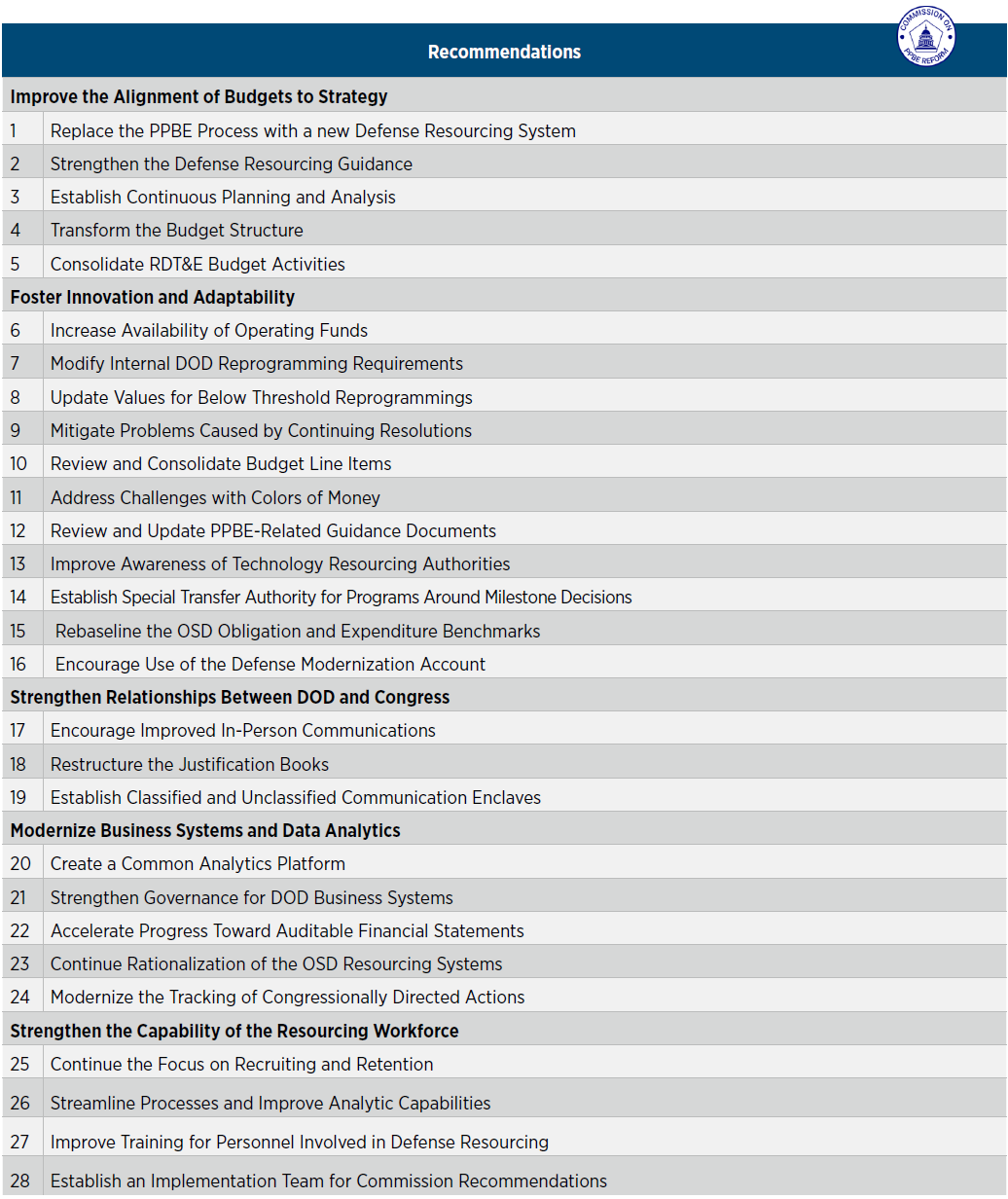

The Commission on Planning, Programming, Budgeting and Execution Reform released a final report on March 6, 2024 recommending a new Defense Resourcing System.
Directed by Section 1004 of the FY22 National Defense Authorization Act, the bipartisan commission led by 14 commissioners with 13 full-time staff conducted a comprehensive 2-year examination of the Defense Department’s Planning, Programming, Budgeting and Execution (PPBE) process to determine effectiveness, alternatives and recommendations for improvement. The Commission conducted over 400 interviews within the Department of Defense (DOD), Congress, industry, academia, and research organizations including the RAND Corporation, which developed the current Planning, Programming and Budgeting system in the 1960s. (The Execution phase was added in 2003.)
The Commission identifies two driving factors, or trends, currently influencing United States national security. The first is China’s rise as “a large, technologically advanced strategic adversary with global reach”, moving China and its capabilities into a strategic category from a regional concern. This month, China’s Premier, Li Qiang, announced military spending would increase by 7.2% in 2024. The second is the speed of technological innovation, which has turned DOD into a consumer of new technologies instead of a leading creator.
Clearly, the current PPBE process is too slow. Program-budget decisions for FY25 finalized in December 2023 likely won’t receive funding before December 2024. The planning and programming phases hamper flexible decision making in a timely manner to match resources to strategy. The budgeting and execution phases are not agile enough to stay relevant with critical advancing technology.
Five focus areas drove research and recommendations:
- Improve the Alignment of Budgets to Strategy;
- Foster Innovation and Adaptability;
- Strengthen Relationships Between DOD and Congress;
- Modernize Business Systems and Data Analytics; and
- Strengthen the Capability of the Resourcing Workforce
These five focus areas are the organizing construct for 28 recommendations, with some recommendations more emphasized, in bold, than others. See Chart I.
IMPROVE THE ALIGNMENT OF BUDGETS TO STRATEGY
This first focus area concentrates on process structure and the organization of the budget. The first recommendation would replace the PPBE with a new Defense Resourcing System (DRS). The proposed system would reduce the current PPBE process to three stages—strategy, resource allocation, and execution. A dedicated strategy stage would allow for better alignment of the Defense Planning Guidance release with the decision-making phases.
Another recommendation would alter the existing defense budget structure to align with strategy, capabilities, or missions. Creating Major Capability Activity Areas would combine funding across all appropriation titles for an area such as ground maneuver forces. Perhaps the closest examples of this concept in the current budget structure are the European Deterrence and Pacific Deterrence Initiatives, which fund specific items for each respective combatant command’s deterrence strategy.
Industry uses the budget to predict future spending, as displayed in the Future Years Defense Program (FYDP), the granting of multi-year procurement authorities, and advance procurement funding levels, especially in major procurement programs such as shipbuilding. Funding data is more helpful to companies in informing business decisions than an un-resourced agency strategy.
FOSTER INNOVATION AND ADAPTABILITY
Addressing concerns about the lack of agility in the PPBE process, the Commission recommended changes to availability of funds (how long funds are available for obligation), reprogramming thresholds and requirements, new start notifications, consolidation of budget line items, and granting special transfer authority for programs around milestone decisions. Allowing for longer times to expend funding and raising Congressional notification thresholds would increase DOD’s flexibility to move money.
The Commission makes specific recommendations for more flexibility with current-year time constraints. The department has a long history of expending appropriated money late in the fiscal year within the one-year accounts—military personnel and operation and maintenance (O&M)—hence the 80/20 rule for O&M, forcing the expenditure of 80% of the FY appropriation by 31 July. This becomes more challenging when Congress fails to pass budgets on time. To alleviate the pressure to spend by 30 September, the Commission recommends 5% carryover of funds into the next year for military personnel and O&M. The Defense Health Program has carryover authority of 1%, but this is more to limit the impact of continuing resolution restrictions on continuity of care.
Reprogramming is a tool agencies use to adjust current funding in the year of execution. Agencies consider initiating a reprogramming for a host of reasons. The most common are to meet an operational need, begin “new start” program in the middle of the fiscal year or before the inevitable continuing resolution passes at the end of the upcoming fiscal year prohibits new starts, or address unforeseen circumstances such as testing failures or delays. Reprogrammings can be Above the Threshold (ATR) or Below the Threshold (BTR); the threshold is an amount of funding of the appropriation title determining notification procedures and approvals. In the FY24 Defense Appropriation Bills, both the House and Senate subcommittee marks increase the Operation and Maintenance (O&M) amount to $15 million from $10 million in FY23. However, while the Senate increases Procurement and Research, Development, Evaluation and Testing (RDT&E) thresholds to $15 million, the House maintains the $10 million from the prior year. Military personnel increased to $15 million in the House and the Senate keeps the level at $10 million.
The Commission recommendation for “Update Values for Below Threshold Reprogrammings” proposes much higher threshold amounts based on the nominal growth of the appropriation titles. The Commission proposes $15 million for military personnel, $30 million for O&M, $40 million for procurement and $25 million for RDT&E. While the amounts may logically make sense as related to the growth of defense funding, raising the amounts reduces transparency for oversight. Billions of dollars of appropriated defense funding were reprogrammed for the southern border wall under the Trump administration, straining long established relationships between the department and congressional defense committees built on trust. Amounts decreased after the border wall reprogrammings in FY19 and for the FY24 bills, various small increases are evident. The Commission takes reforming BTRs one step further, suggesting removing them in favor of a percentage system for each appropriations title, starting with pilot programs for a gradual approach. It will take years for Congress to increase the amounts to the levels proposed in this report since it decreases the ability of Congress to conduct oversight.
Thresholds apply to new starts as well. Another way to begin a program is to notify Congress with a letter about the proposed new start. While there is no dollar amount tied to a new start notification letter, there is a $5 million threshold for any new start related to defense innovation acceleration or rapid prototyping demonstration. The Commission recommends raising the new start threshold with the proposed BTR amounts discussed earlier. The Commission also recommends allowing new starts on a case-by-case basis in continuing resolutions, which prohibits any new starts as a forcing function.
Even though the department has expanded rapid acquisition authorities and organizations for engaging non-traditional, more innovative, the Commission found there is a reluctance to use Other Transaction Authority (OTA), as the current system rewards risk-averse behavior. For oversight, OTAs are hard to manage as there is really no notification required for the majority of these types of transactions. However, according to a Report to Congress On the Use of Other Transaction Authority for Prototype Projects In FY 2022, OTA funding grew 386% from $2.2 billion in 2017 to $10.7 billion in 2022.
Recent language in the FY24 Senate Defense Appropriations Report may most clearly explain their view of innovation and fiscal responsibility “…Many of the controls and oversight mechanisms in place within statute and regulation are the result of previous instances of financial or acquisition mismanagement, unacceptable cost growth, or wasteful acquisition strategies that delayed fielding timeframes for programs. Therefore, it is imperative that speed and innovation do not come at the expense of sound financial, acquisition, and management best practices essential to delivering capability to the warfighter on time and on budget.”
STRENGTHEN RELATIONSHIPS BETWEEN DOD AND CONGRESS
The Commission acknowledges that the relationship between the budget communities of on the Hill and the Defense Department, could be improved. The Commission encourages improved in-person communications. Taking Hill engagements seriously, as well as service in the legislative positions by defense personnel, may help to improve the current situation.
Communication is imperative to establishing and maintaining a good relationship. Establishing a way to provide information in a timely and accessible manner would be to establish classified and unclassified enclaves. This recommendation may be based on the Intelligence Community’s system shared with Congressional Committees of jurisdiction.
MODERNIZE BUSINESS SYSTEMS AND DATA ANALYTICS
One of the Defense Department’s many issues with achieving an audit are the state of their enterprise resource programs. Funding has been steadily invested in ensuring the validity of data and the sharing of financial information across the department. Business systems within the department range from long-used tailormade databases to commercial off the shelf systems. Moving to a modern digital culture with wide-reaching standards adhered to across the financial enterprise is a goal the Commission encourages through commonality and stronger governance.
STRENGTHEN THE CAPABILITY OF THE RESOURCING WORKFORCE
A plan or program is only as good as the people executing them. The Commission realized this basic fact and addressed the resourcing workforce. Talent management, recruiting the right skill sets, providing education, and retaining the workforce is critical. Capable financial analysts are the coin of the realm for successful and accurate financial information.
Proper use of analytical tools for tasks such as data calls or execution analysis can assist with the overwhelming workload for the financial analysts, budgeteers and operations research analysts. Training provided for new financial systems, data analytic training and exposure to best practices within the private sector can all aid in making the workforce stronger.
The last recommendation—“Establish an Implementation Team for Commission Recommendations”—suggests establishing an implementation team separate from the resourcing workforce to serve for three to five years to implement the 28 recommendations.
This last recommendation, like many of the others, requires the cooperation of Congress and DOD. Implementing many of the recommendations will greatly change the current defense budget ecosphere. Perhaps this directive from the FY24 Senate Defense Report speaks for to the challenges ahead: “The Committee directs that unless specified elsewhere in this report, no changes shall be made to the appropriations structure with submission of the President’s fiscal year 2025 budget request without prior consultation of the defense appropriations committees of the House of Representatives and the Senate.”


Chart I. Source: Commission on Planning, Programming, Budgeting and Execution Reform